UNDERWATERING A LAWN
What are the Symptoms of an Underwatered Lawn?
Stop Trusting the “Lawn Experts”!
If you ask ten different lawn care experts how to water a lawn, you will receive ten different answers. Should you follow the advice of the sprinkler guy, the master gardener friend, the neighbor with the perfect lawn, or the guy that mows your lawn? Many “lawn care experts” lack a clear understanding of how to properly water a lawn, often resulting in overwatering certain areas while underwatering others. Proper lawn watering is the most crucial aspect of lawn and tree care and if a sprinkler system is poorly programmed, it can cause significant damage to the lawn.
Learn the 1-2-3-2-1 Technique
Organo-Lawn has developed the ideal way to water a lawn and we call it the 1-2-3-2-1 lawn watering technique. This special lawn watering technique is based on logic and science and is easy to understand.
Lawn Watering
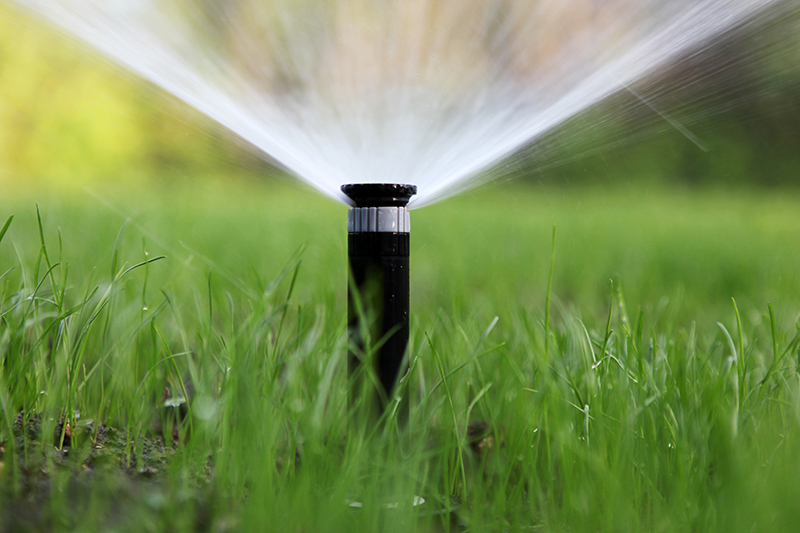
Negative Impacts of Bad Lawn Watering Practices
Improper lawn watering can cause lawn fungus problems, kill beneficial microbial activity in soils, and cause shallow digging grass roots. The majority of lawn problems are caused by either under watering, over watering, daily watering, and/or poorly adjusted sprinkler heads. During a sprinkler audit, it is very common to find both over watering issues and underwatering issues.
Based on Science and Logic
The 1-2-3-2-1 lawn watering is based on science and it will reduce weed pressure, prevent grub attacks, reduce soil compaction, stimulate microbial activity in soils, and promote deep digging grass roots. Organo-Lawn invented this special lawn watering technique specifically for the climate of Boulder and Fort Collins Colorado, but this technique is will work on lawns in every climate.
Perfect Watering
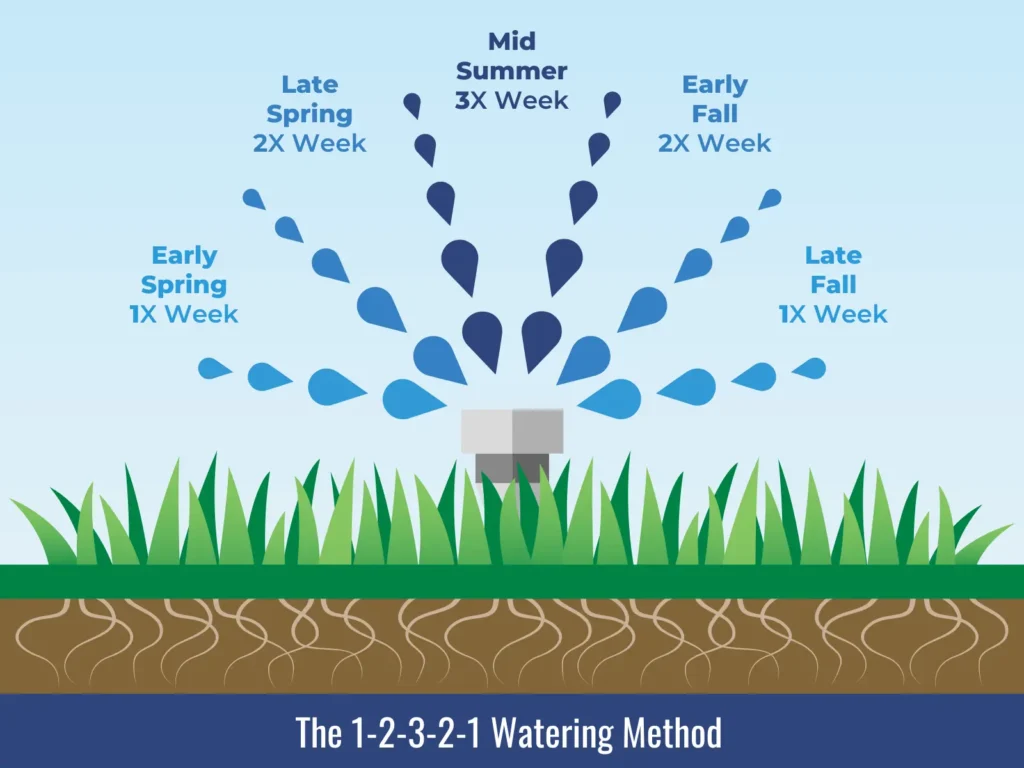
Symptoms of a Drought Stressed Lawn
Short Grass Roots
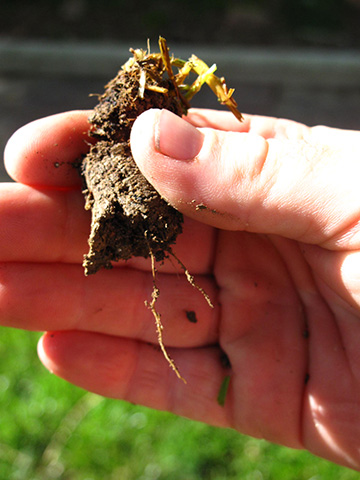
Healthy grass roots should dig about 8-12 inches deep into the soil. The soils sample above shows grass roots that are only digging 3 inches deep.
Grass Clumping
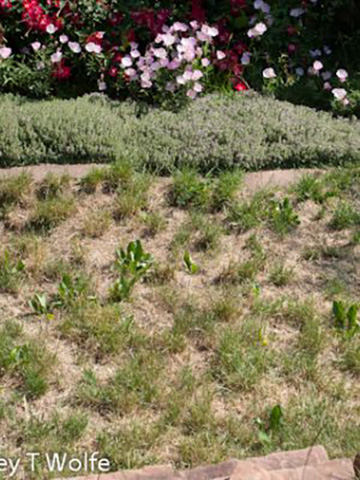
Grass growing in clumps is a clear sign of drought stress. This area of the lawn is not receiving enough water which is causing the clumpy look to the lawn.
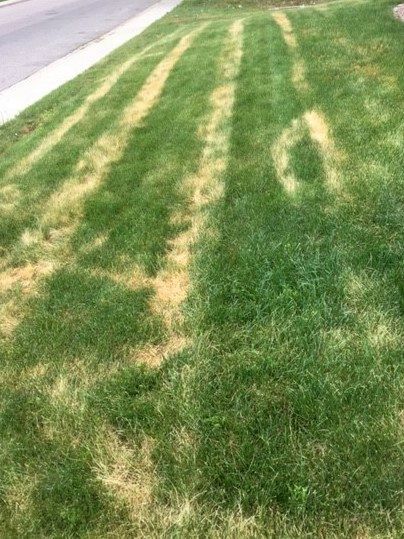
This lawn is suffering from a disease called Dollar Spot Fungus, or Ascochyta Leaf Blight. This develops in lawns with shallow grass roots caused by improper lawn watering..
How to Tell if the Lawn is Underwatered
Shallow Frequent Lawn Watering is Bad
Signs of an underwatered lawn include the presence of a heat and stress fungus known as Ascochyta leaf blight, yellowing turf, and footprints that remain visible for several minutes after walking on the lawn. Another clear indicator of insufficient watering is dry soil with shallow grass roots.
Microbes Need Moisture
Dry soils also lack beneficial microbial activity, as these microbes require moisture to survive. A properly watered lawn will have moist soil, but not be over-saturated. Maintaining the right moisture level is essential for creating a living soil rich in beneficial microorganisms. Be sure to allow the soil to dry out between watering.
Coverage Issue
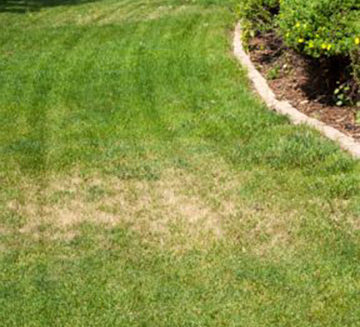
What are the Symptoms of a Lawn that is Drought Stressed?
Visual Symptoms
Grass Turning Brown or Yellow
- Grass blades lose their green color and start turning brown or yellow as they dry out.
- If the lawn is mostly dormant, the grass may appear uniformly brown.
Wilted or Curled Grass Blades
- Grass blades may wilt, curl, or roll inward to conserve moisture.
- The texture becomes brittle and crisp rather than soft and flexible.
Footprint Marks
- Footprints or mower tracks remain visible because the grass blades lack the moisture to spring back.
- This indicates reduced grass elasticity and dehydration.
Patchy Growth
- Uneven patches of brown or thinning grass, especially in areas with poor soil or direct sunlight.
Very Dry Lawn
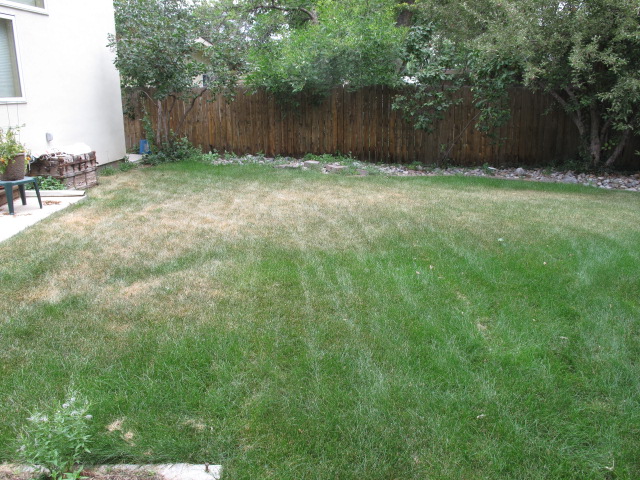
Cracked Soil
- Prolonged dryness can cause the soil to crack, especially in clay-heavy soils.
Dry, Hard Soil
- When a screwdriver or similar object is inserted into the ground, it’s difficult to penetrate more than an inch or two.
- The soil feels dry, dusty, or hard to the touch.
Discoloration
- Grass may look dull or grayish-green during the hottest parts of the day.
- Areas in direct sunlight may show stress sooner than shaded areas.
Cracked Soil
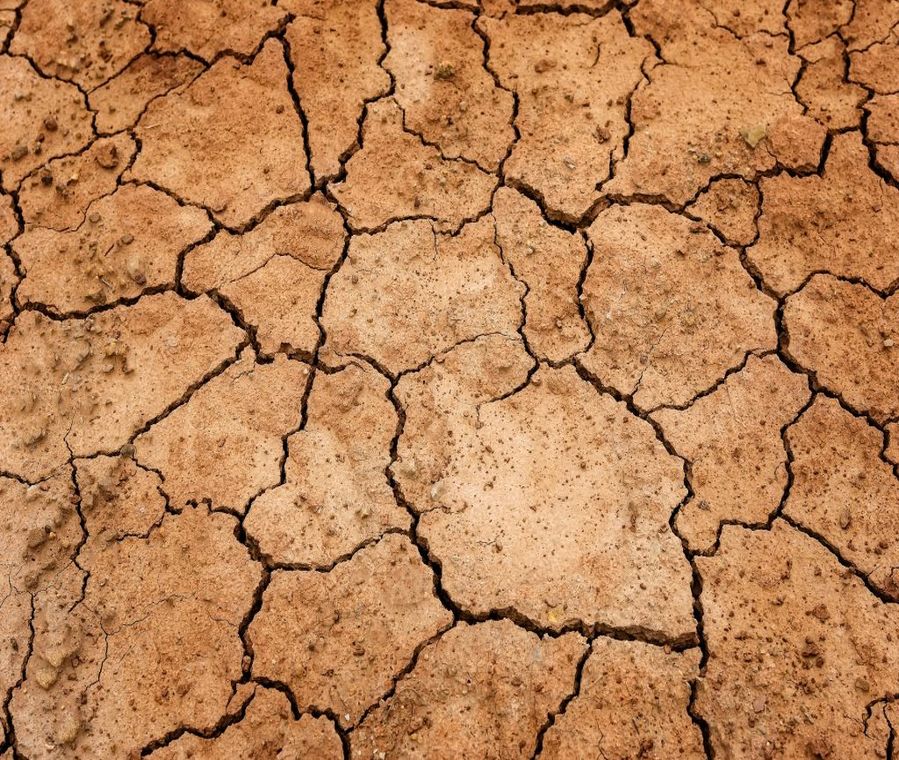
How to Recover a Lawn from Drought Stress
Back-to-Back-to-Back Waterings
Water the Lawn Deeply Once per Day for 3-4 Consecutive Days
- Apply about .4 – .7 inches of water per watering. The water amount depends on sun exposure – less water for full shade and more water for full sun areas.
- Water early in the morning to minimize evaporation.
Avoid Applying a Fertilizer Until the Soil Has Recovered
- Use a soil probe or moisture meter to measure how deeply water is penetrating.
- Apply an All Organic Soil Conditioner Like Humate for Severely Stressed Lawns
Improve Soil Health
- Aerate the soil to improve water retention and reduce compaction (Do not aerate in the peak summer months).
- Add organic matter like compost to enhance soil structure.
- Apply an All Organic Soil Conditioner Like Humate for Severely Stressed Lawns
Be Patient
- The lawn should show signs of recovery within a day or two of the initial watering. Full recovery might take up to 3 weeks.
Very Dry Lawn
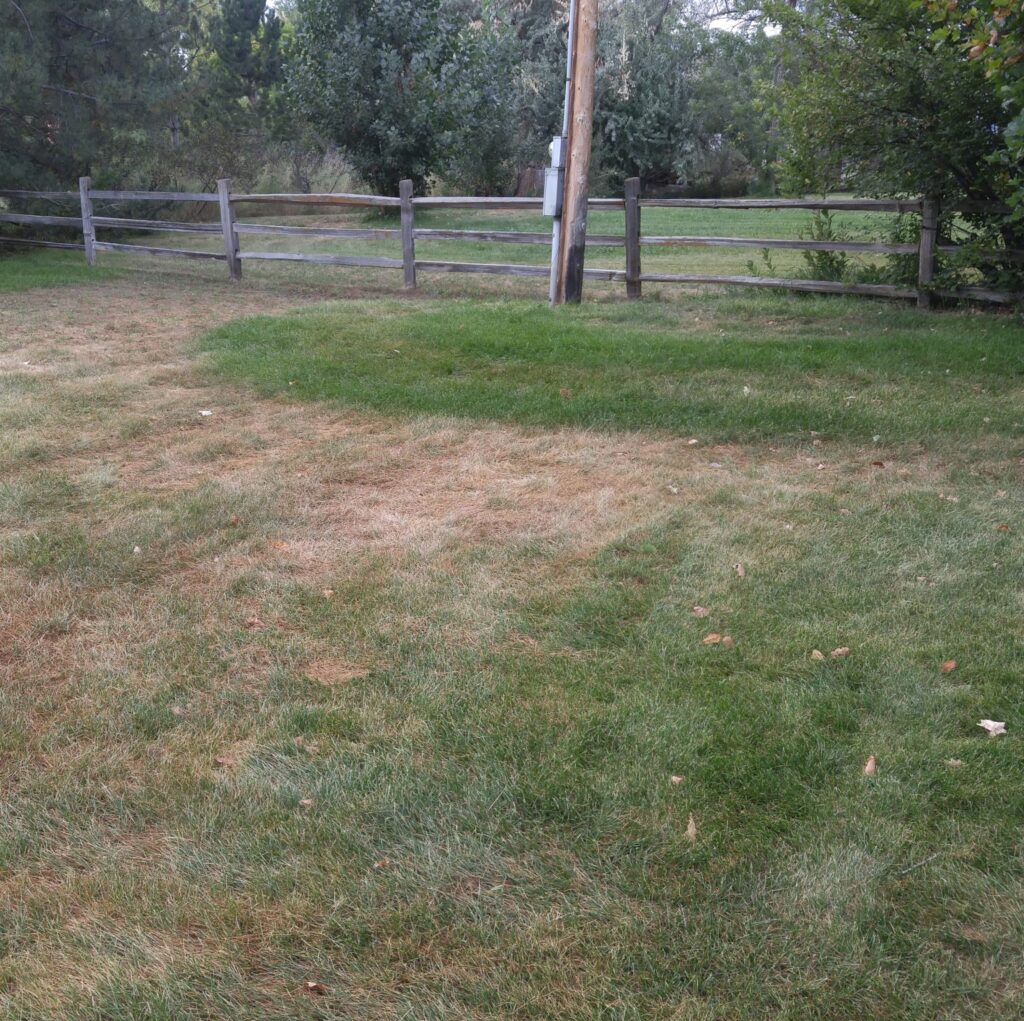
Audit the Sprinkler System
- Make sure the lawn is being watered according to the 1-2-3-2-1 lawn watering principles so the drought stress won’t return.
Repeat the 3-4 Consecutive Days of Watering if Necessary
- If the lawn is not fully recovered in 3 weeks time, it is fine to repeat the consecutive days of watering to get the lawn to fully recover.
Very Dry Lawn
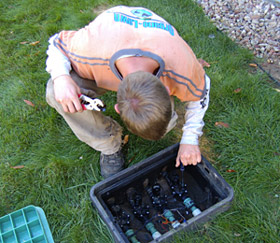
Learn How to Water a Lawn Based on Science and Logic
To schedule a sprinkler audit please call our office at
(303) 499-2000 Boulder or (970) 225-9425 Fort Collins.
Symptoms of Underwatering a Lawn FAQs
What is Worse for a Lawn – Underwatering or Overwatering?
Both underwatering and overwatering are harmful to a lawn, but an underwatered lawn can usually be repaired in a few weeks while an overwatered lawn may take many months to repair.
Underwatering:
- Grass becomes stressed, turns brown, and goes dormant.
- Soil compacts, reducing root growth and nutrient absorption.
- Weakened grass is more susceptible to weeds and pests.
- Repaired quickly with 3-4 consecutive days of deep watering and then returning to the 1-2-3-2-1 technique.
Overwatering:
- Leads to waterlogged soil, suffocating roots by limiting oxygen access.
- Encourages fungal growth, mold, and disease.
- Washes away nutrients, leaving the grass malnourished.
- Promotes shallow root growth, making the lawn more dependent on frequent watering.
- Damages the microbial population in the soil which will take a long time to recover
Conclusion?
Overwatering is often worse because it can lead to long-term issues like root rot, nutrient loss, damage to the soil, and increased vulnerability to disease. While underwatered grass can recover with proper watering, overwatered lawns may require extensive rehabilitation.
Additional Lawn Watering FAQs
Water Turns On, Pauses Watering, Soaks Into the Soil, Then Water Starts Again
Setting up a sprinkler controller for a soak cycle involves programming it to water your lawn in shorter bursts with pauses in between. This allows water to penetrate the soil deeply without causing runoff or pooling, which is especially important for compacted soil or slopes. Here’s how to set it up:
Understand Your Sprinkler Controller
- Modern Controllers: Many modern controllers have specific “soak cycle” or “cycle and soak” settings built-in.
- Older Controllers: If your controller doesn’t have this feature, you’ll need to manually program start and stop times to achieve the same effect.
Plan Your Watering Schedule
- Determine how much water your lawn needs per zone. There are general recommendations for how to do this on the 1-2-3-2-1 lawn watering page.
- For best results, measure your sprinkler output (use a rain gauge or shallow container) to calculate how long you need to run the sprinklers to deliver the required amount of water.
Divide the Watering Time
- Split the total watering time into shorter cycles:
- For example, if your lawn needs 30 minutes of water in one zone, break it into three cycles of 10 minutes.
- Add up all the shorter cycle times of each zone.
- For example, if the shorter cycles of each zone are 10 minutes, 15 minutes, 5 minutes, 20 minutes, 3 minutes, and 10 minutes. This is a total of 63 minutes.
- Program 3 different start times into the controller with at least the total run time of all the zones spaced out between start times.
- For example: Start Time 1 – 2:00 AM, Start Time 2 – 3:30 AM, Start Time 3 – 5:00 AM
- Notice that there is 90 minutes between start times which is plenty of time to complete the 63 minutes of zone run time.
Include a little soak period between each watering cycle to allow water to percolate into the soil.
Note: For modern controllers dividing the watering time is not necessary. Just input the total time and select soak and cycle and the controller will do this automatically.
Grass requires varying amounts of water at different times of the year. Several factors should be considered when determining the watering needs of your lawn.
Sun Exposure
The first factor is the amount of sunlight the lawn receives. For example, a south-facing lawn that receives full sun will need about 0.6 to 0.7 inches of water per watering session. In contrast, a west or east-facing lawn that gets partial sun will require around 0.5 to 0.6 inches, while a north-facing lawn or one in full shade will need approximately 0.4 to 0.5 inches of water.
Outdoor Temperature
- 1 Day per Week – During the spring and late fall, lawns typically need only one watering per week.
- 2 Days per Week – In late spring and early fall, they generally require two waterings per week.
- 3 Days per Week – However, during the hot summer months, lawns may need to be watered three times a week.
This lawn watering technique is called 1-2-3-2-1 lawn watering. Click here for a detailed explanation on how this technique can be implemented.
Important Note: Each sprinkler system is different, and the output of each sprinkler zone can vary as well. To determine how long it takes to water your lawn effectively, it’s essential to measure each zone in your sprinkler system accurately. Using a rain gauge or a flat-bottomed, flat-sided container is the best method for obtaining an accurate measurement.